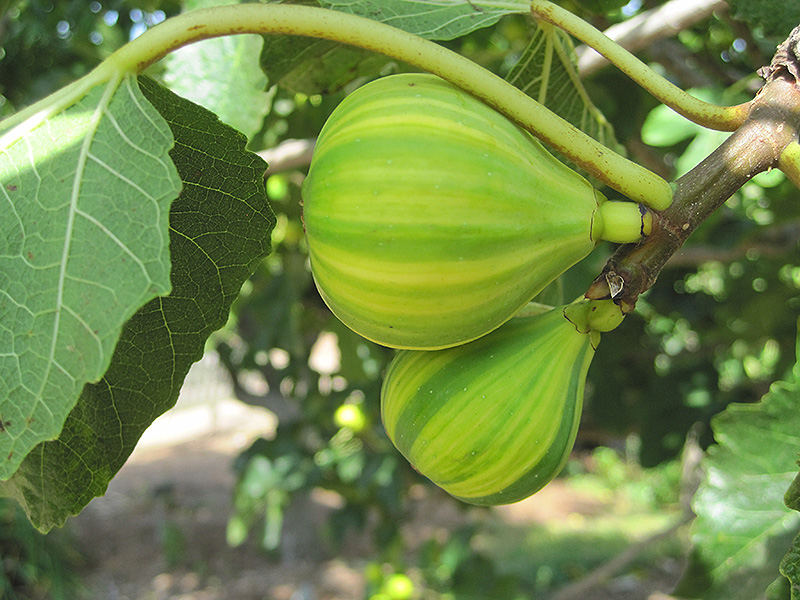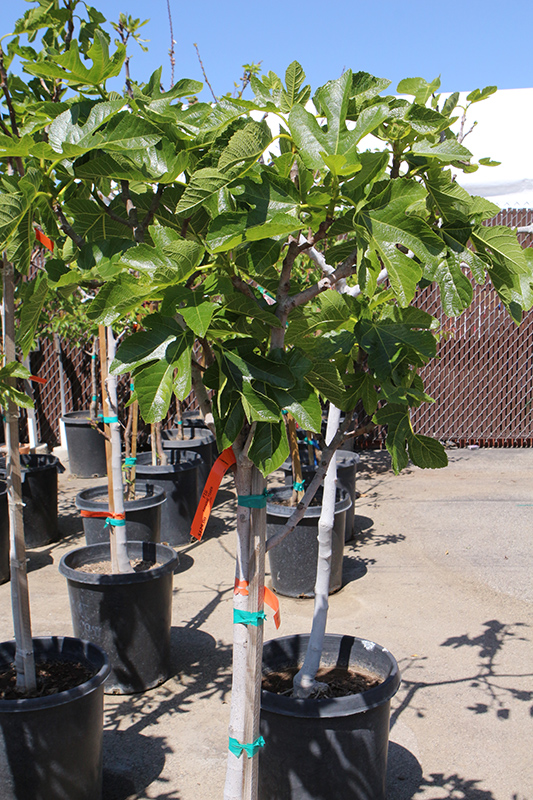Height: 20 feet
Spread: 20 feet
Sunlight:
![]()
![]()
Hardiness Zone: 7a
Other Names: Tiger Panache Fig, Tiger Striped Fig
Description:
An attractive deciduous garden tree producing exceptional green and yellow striped fruits with red flesh; attracts birds; prune in late winter to maintain size and shape; needs hot exposure to ripen fruit in cooler areas
Edible Qualities
Panache Fig is a small tree that is commonly grown for its edible qualities, although it does have ornamental merits as well. It produces yellow fruit (technically 'pomes') with lime green stripes and red flesh which are usually ready for picking from mid to late fall. The fruits have a sweet taste and a fleshy texture.
The fruit are most often used in the following ways:
- Fresh Eating
- Cooking
- Preserves
Features & Attributes
Panache Fig has attractive dark green foliage with light green veins on a tree with a round habit of growth. The lobed leaves are highly ornamental but do not develop any appreciable fall color. The fruits are showy yellow pomes with lime green stripes, which are carried in abundance from late summer to late fall. The fruit can be messy if allowed to drop on the lawn or walkways, and may require occasional clean-up.
This is a multi-stemmed deciduous tree with a more or less rounded form. Its average texture blends into the landscape, but can be balanced by one or two finer or coarser trees or shrubs for an effective composition. This plant will require occasional maintenance and upkeep, and is best pruned in late winter once the threat of extreme cold has passed. It is a good choice for attracting birds to your yard, but is not particularly attractive to deer who tend to leave it alone in favor of tastier treats. It has no significant negative characteristics.
Aside from its primary use as an edible, Panache Fig is sutiable for the following landscape applications;
- Accent
- Shade
- Hedges/Screening
- General Garden Use
- Container Planting
Planting & Growing
Panache Fig will grow to be about 20 feet tall at maturity, with a spread of 20 feet. It has a low canopy with a typical clearance of 1 foot from the ground, and is suitable for planting under power lines. It grows at a medium rate, and under ideal conditions can be expected to live for 50 years or more. This is a self-pollinating variety, so it doesn't require a second plant nearby to set fruit.
This tree is quite ornamental as well as edible, and is as much at home in a landscape or flower garden as it is in a designated edibles garden. It does best in full sun to partial shade. It does best in average to evenly moist conditions, but will not tolerate standing water. It may require supplemental watering during periods of drought or extended heat. This plant should not require much in the way of fertilizing once established, although it may appreciate a shot of general-purpose fertilizer from time to time early in the growing season. It is not particular as to soil type or pH, and is able to handle environmental salt. It is highly tolerant of urban pollution and will even thrive in inner city environments. Consider applying a thick mulch around the root zone in winter to protect it in exposed locations or colder microclimates. This is a selected variety of a species not originally from North America.
Panache Fig is a good choice for the edible garden, but it is also well-suited for use in outdoor pots and containers. Because of its height, it is often used as a 'thriller' in the 'spiller-thriller-filler' container combination; plant it near the center of the pot, surrounded by smaller plants and those that spill over the edges. It is even sizeable enough that it can be grown alone in a suitable container. Note that when grown in a container, it may not perform exactly as indicated on the tag - this is to be expected. Also note that when growing plants in outdoor containers and baskets, they may require more frequent waterings than they would in the yard or garden.
Disclaimer - This Plant Finder tool is an online resource representing many of the varieties that we carry over the course of the season, and is intended for informational purposes only. Inventory varies seasonally, so we cannot guarantee that every plant will be in stock at all times - please contact the store directly for current availability. It does not include our entire selection of plants, so be sure to visit our store to see varieties that may not be represented on this list.


